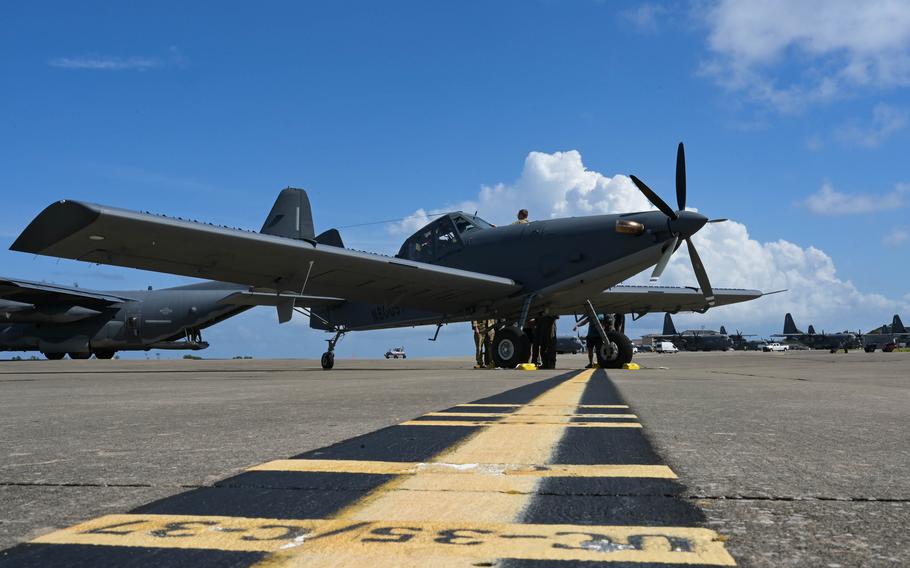
Air Force Special Operations Command received two AT-802U trainer aircraft at Hurlburt Field, Fla., on June 28, 2024. These aircraft will be used to train test pilots in preparation for the new Armed Overwatch (OA-1K) variant. (Ty Pilgrim/U.S. Air Force)
The Pentagon should further analyze the capabilities of the new aircraft that defense officials have selected to watch over special operators working in austere environments and consider slowing its purchase of the planes, a federal watchdog warned in a new report.
The Government Accountability Office — an independent federal auditing agency — warned in a report published last week that U.S. Special Operations Command had yet to complete an analysis justifying its plans to purchase dozens of the new planes, dubbed OA-1K armed overwatch aircraft. The warning follows a similar assessment completed by GAO in December when the watchdog urged SOCOM and the Defense Department to slow the $2 billion armed overwatch program until they could determine precisely how many of the new aircraft are needed.
In its latest report — based on new findings including a classified assessment of SOCOM’s armed overwatch program — GAO suggested the Pentagon reevaluate the number of OA-1Ks needed, limit the purchases to testing aircraft for now, and study the risks and challenges special operators could face when supported by the planes. GAO officials wrote questions remained about how to use the new aircraft and the logistics programs needed to deploy them into the austere locations where they are believed to be most useful.
“It is essential that the Department of Defense act quickly to fully address GAO’s open recommendations,” the report reads. “Otherwise, it risks buying more aircraft than it needs. In addition, it may not be able to fully utilize the aircraft because it has not addressed identified challenges.”
The GAO report did not elaborate on most of the challenges that it found with the OA-1K aircraft, which officials said are detailed in the classified report on the program. The OA-1K is a single-engine, turboprop aircraft manufactured by L3 Harris and Air Tractor. It is based on the manufacturers’ AT-802U Sky Warden, a heavily modified crop dusting-style plane that can be outfitted to conduct intelligence, surveillance and reconnaissance operations and can carry 500-pound to 1,000-pound bombs and guns from .50-caliber machine guns to 20mm cannons.
SOCOM earlier this year trimmed the OA-1K program from a planned 75-plane fleet down to 62 planes. The command said the cuts were based on budgeting issues and not based on the GAO’s recommendations in December.
The command has continued to support the armed overwatch program, which it aims to use to replace two Air Force Special Operations Command aircraft — the U-28 Draco and MC-12 manned intelligence, surveillance and reconnaissance planes.
The GAO report warns more analysis is needed to ensure the OA-1K can perform all the missions the older Air Force aircraft have been used for in recent years. But it also recommended the Pentagon evaluate whether the program makes sense as the military turns its attention from counterterrorism operations in places such as Afghanistan and Iraq toward global power conflicts with near-peer militaries such as those of Russia and China.
Even in the austere locations that special operators will likely continue to work in locations such as Africa and Middle East, the GAO questioned whether the OA-1K aircraft would prove able to provide overwatch capabilities, citing concerns from some in the program.
“Special operations commands identified logistical and operational challenges that could inhibit SOCOM’s ability to effectively deploy and operate the aircraft as intended,” the GAO wrote. “Users said that the Armed Overwatch aircraft may not meet their mission needs because of these challenges.”
GAO said the Pentagon agreed to reevaluate the number of OA-1K aircraft that it should purchase. Pentagon officials partially agreed with other GAO recommendations, including on further risk assessments of the program, further study of unspecified challenges in deploying the aircraft and an assessment of “whether the acquisition program remains an affordable priority.”
The Pentagon received its first two OA-1K aircraft in June. In July, the two planes were sent to Will Rogers Air National Guard Base in Oklahoma where pilots began testing them. The Air Force plans to build its OA-1K training at Will Rogers and was in the process of establishing the Total Force Integration OA-1K Formal Training Unit there, base officials said last month.